BlackGEM (Blackhole Gravitational-wave ElectroMagnetic counterpart array)
Astronomy and Telescopes
Overview
BlackGEM is an array of optical telescopes located at ESO's La Silla Astronomical Observatory in Chile's Atacama Dessert. This system is specifically designed to detect the optical counterparts from gravitational wave sources detected with Virgo and LIGO. Principal investigator of the array is Paul Groot. Initially, BlackGEM comprises 3 telescopes, each at 0.65 meter in diameter, and the aim is to eventually expand the array to 15 telescopes. The telescopes can look at different parts of the sky, or work together as a single 3.6-meter telescope. The array is largely robotic and remotely controlled from Radboud University of Nijmegen, the Netherlands. It was jointly developed by Radboud University, the Netherlands Research School for Astronomy (NOVA), and the KU Leuven, Belgium. 1)
BlackGEM’s scientific goals are to detect and characterise optical counterparts to gravitational wave detections. To enable this, it will conduct an all-sky survey of the southern sky, perform a bi-weekly scan of the southern sky, and characterise intra-night transients, new stars that appear or disappear within a single night.
Events that produce detectable gravitational waves are expected to occur within approximately 650 million light-years of Earth. Many will therefore be located in or near resolved galaxies and will be faint. It is essential for BlackGEM to have high spatial resolution in order to resolve and accurately locate these sources against the background of the night-sky, making La Silla — with its excellent weather and thin atmosphere — an ideal observing site.
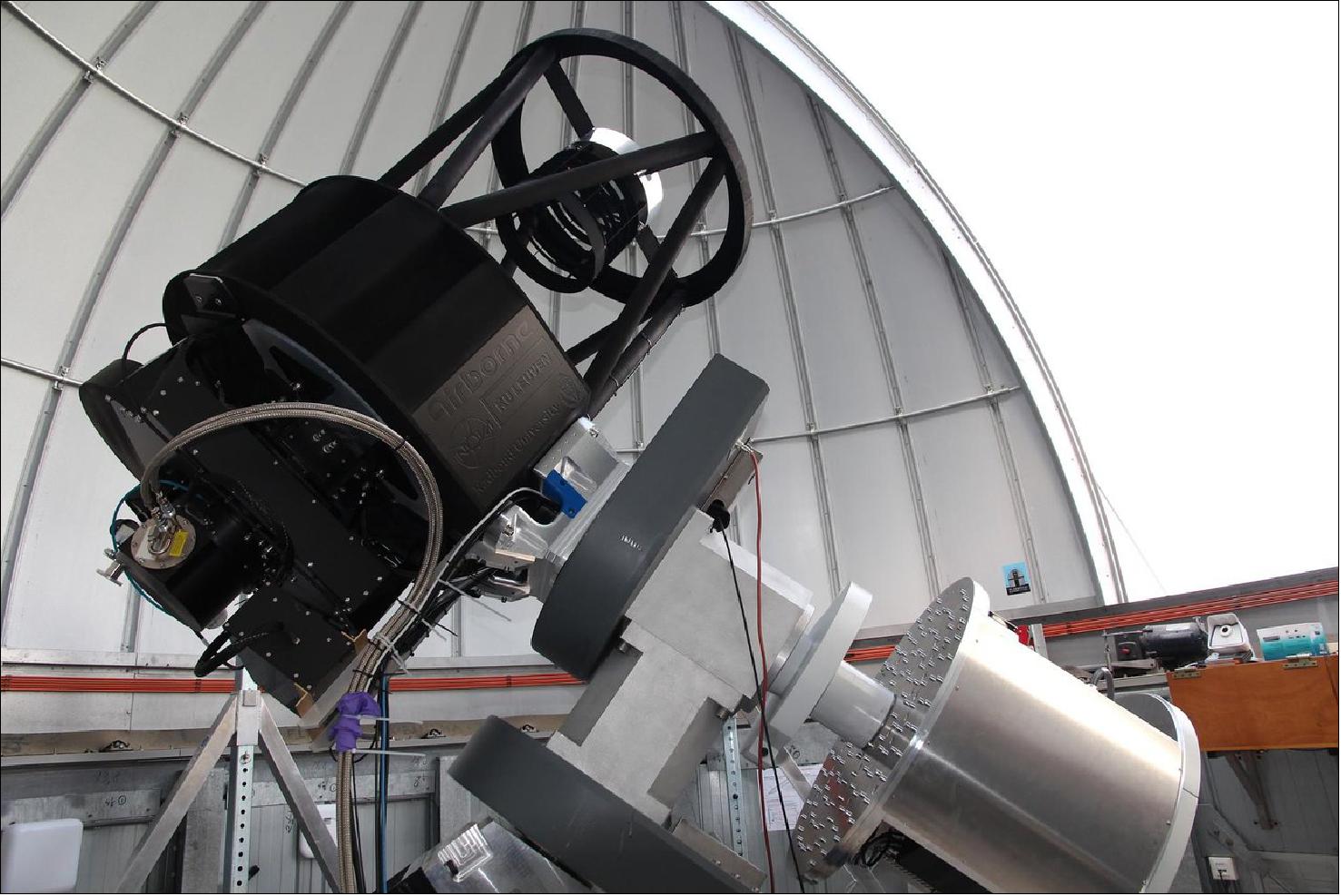
Specifications
Location: BlackGEM L is located at the ESO La Silla site in Chile. The telescopes are located at the ESO La Silla site. Each telescope is mounted on top of a 7 meter high double-walled steel cylinder. The inner cylinder holds the telescope and the outer cylinder supports the dome floor and the clam-shell dome. This way the telescope-bearing structure is shielded from sun and wind.
Altitude: 2375 m
Enclosure: 4.5 m clamshell dome per telescope
Type: Optical survey telescope
Optical design: Modified Dall-Kirkham (Wynn-Harper)
Diameter Primary M1: 3 x 0.65 m
Material Primary M1: Fused silica
Diameter Secondary M2: 0.26 m, tip-tilt controlled
Material Secondary M2: Fused silica
Mount: Equatorial
First Light date: 2023
Active optics: Yes, M2 tip-tilt controlled
Camera: 110 Megapixels per telescope (a single 10500 x 10500 pixel CCD detector)
Filters: Sloan u,g,r,i,z + q (440–720 nm)
The secondary mirror can be steered with piezo actuators. This system is used for guiding and focussing of the telescope.
Each BlackGEM telescope has a set of 6 optical filters: a wide-band g+r filter which is used for transient searches and a Sloan-based set (u, g, r, i, z) to provide color information.
The typical exposure time is 60s.
The telescopes have a built-in atmospheric dispersion corrector to be able to achieve good image quality closer to the horizon, which is essential to follow up gravitational wave detections wherever they happen on the sky.
Electronics on the telescope are water cooled to prevent heat from causing turbulence in the dome. 2)
Science with BlackGEM
BlackGEM is joining the search for some of the most powerful and dramatic events in the Universe: merging neutron stars and black holes. Such exotic events cause ripples in the fabric of spacetime known as gravitational waves, and BlackGEM will work in conjunction with the new generation of gravitational wave detectors such as LIGO and Virgo to follow up these events in visible light. BlackGEM will pinpoint the sources responsible for gravitational waves so that bigger telescopes — such as ESO’s Very Large Telescope (VLT) — can carry out detailed follow-up observations, providing astronomers with insight into some of the most extreme events in the cosmos.
The BlackGEM array can also function as a highly capable survey telescope and a portion of its time will be spent surveying the southern skies (30,000 square degrees in six optical filters). Detailed surveys provide astronomers with statistical information about objects in the sky, enabling, for example, studies of galactic evolution from the early Universe to today. During this survey, BlackGEM will also study fast (less than one day) transient sources. Transients are astronomical events that only last for a certain amount of time; usually these are deep sky events such as supernovae, gamma-ray bursts, transits, and tidal disruption events.
The BlackGEM consortium comprises: NOVA (Netherlands Research School for Astronomy, the national Dutch alliance in astronomy between the University of Amsterdam, University of Groningen, Leiden University, and Radboud University); Radboud University, the Netherlands; KU Leuven, Belgium; the Weizmann Institute, the Hebrew University of Jerusalem and Tel Aviv University, Israel; the University of Manchester and the Armagh Observatory and Planetarium, UK; Texas Tech University, the University of California at Davis and the Las Cumbres Observatory, USA; the University of Potsdam, Germany; the Danish Technical University, Denmark; the University of Barcelona, Spain; and the University of Valparaíso, Chile.
The European Southern Observatory (ESO) enables scientists worldwide to discover the secrets of the Universe for the benefit of all. We design, build and operate world-class observatories on the ground — which astronomers use to tackle exciting questions and spread the fascination of astronomy — and promote international collaboration in astronomy. Established as an intergovernmental organisation in 1962, today ESO is supported by 16 Member States (Austria, Belgium, the Czech Republic, Denmark, France, Finland, Germany, Ireland, Italy, the Netherlands, Poland, Portugal, Spain, Sweden, Switzerland and the United Kingdom), along with the host state of Chile and with Australia as a Strategic Partner. ESO’s headquarters and its visitor centre and planetarium, the ESO Supernova, are located close to Munich in Germany, while the Chilean Atacama Desert, a marvelous place with unique conditions to observe the sky, hosts our telescopes. ESO operates three observing sites: La Silla, Paranal and Chajnantor. At Paranal, ESO operates the Very Large Telescope and its Very Large Telescope Interferometer, as well as survey telescopes such as VISTA. Also at Paranal ESO will host and operate the Cherenkov Telescope Array South, the world’s largest and most sensitive gamma-ray observatory. Together with international partners, ESO operates ALMA on Chajnantor, a facility that observes the skies in the millimetre and submillimeter range. At Cerro Armazones, near Paranal, we are building “the world’s biggest eye on the sky” — ESO’s Extremely Large Telescope. From our offices in Santiago, Chile we support our operations in the country and engage with Chilean partners and society.
• August 9, 2016: The announcement earlier this year of the first direct detection of gravitational waves by the LIGO detectors brought gravitational wave astrophysics to the centre of science and research. In order to better understand these gravitational wave events and to maximize the science return from their detection, it will be essential to observe them in the electromagnetic domain as well. For that reason, the BlackGEM project was started by the Department of Astrophysics of the Radboud University Nijmegen (NL), partnering with NOVA (NL) and the Institute of Astronomy of the KU Leuven University (BE). BlackGEM is an array of telescopes dedicated to and optimized for the search of the optical counterparts of gravitational wave events, like the merging of two neutron stars or the collision of a neutron star with a black hole. 3)
However, the observations of these electromagnetic counterparts are not straightforward. These sources will probably be faint (MV~22) and transienting quickly (~1 day). The large error window of GW detections by facilities like LIGO and VIRGO (typically ~100 square degrees) requires BlackGEM to search with high sensitivity over a very large field of view. Therefore, each telescope will provide seeing-limited imaging over a wide field of 2.7 square degrees. This gives a total sky coverage of 8 square degrees for an array of 3 telescopes. It is envisioned that in a later stage and with the entrance of new partners in the project, the array will be extended with more telescopes, leading to an even larger total coverage. The array consists of identical Dall-Kirkham Cassegrain telescopes with a 65 cm primary mirror (f/5.5) in a carbon fibre structure. The telescopes will be fully robotic with a goal of one-year periods of maintenance-free and unattended operation. Figure 2 shows a design model of the BlackGEM telescope. We plan to install and commission BlackGEM at the ESO La Silla Observatory in Chile early 2018.
Currently, a prototype for the BlackGEM telescopes is already under construction. After assembly, integration and testing in the Netherlands, this telescope named MeerLICHT, will be installed in Sutherland (South Africa) at the MeerKAT radio array site. There it will complement the radio observations from MeerKAT, the precursor to the Square Kilometre Array (SKA). MeerLICHT will co-point the same field as the radio dishes and provide simultaneous optical observations.
This contribution focuses on the design of the cryostat that houses the CCD detector and the associated cryostat monitoring and control system. The outline of the paper is as follows: in section 2 we introduce the BlackGEM/MeerLICHT (hereafter solely referred to as BlackGEM) cryostats as well as their detector system, section 3 discusses the thermomechanical design of the cryostat, in section 4 we present the PLC-based cryostat control system, followed by a performance discussion in section 5 and some conclusions in section 6.

The BlackGEM detector system is based on the back-illuminated STA1600 CCD from Semiconductor Technology Associates, Inc. (STA), together with their Archon CCD controller. The STA1600 CCD is an impressive piece of silicon (Figure 3), consisting of 10560 x 10560 9 µm pixels. It has an image area of 95 mm x 95 mm that corresponds with a field of view of 1.65 x 1.65 degrees in the focal plane of a BlackGEM telescope. The spatial sampling amounts to 0.56 arcsec/pixel. The detector is mounted on a gold-plated Invar base, weighing a solid 1.2 kg.
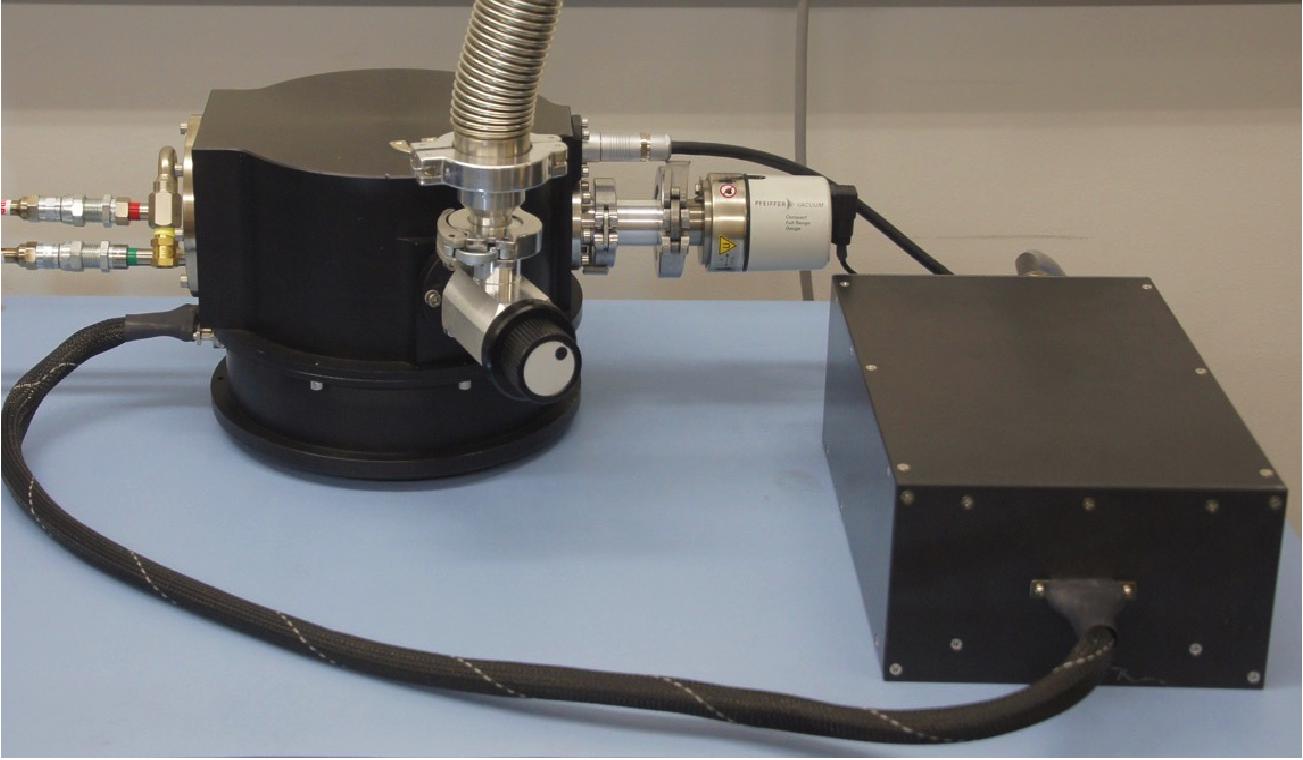
Gravitational waves and Light
Our best description of the fabric of space and time itself is Einsteins Theory of General Relativity. Immensely successful right after its publication in 1905, one main feature of the Theory remained untested for 100 years: the existence of gravitational waves. Space and time are not 'nothing' but is a very stiff framework in which bodies such as the Sun and the stars move. According to Einstein this fabric of space-time itself can be shaken when very massive objects suddenly move: acceleration of mass. These sudden motions occur when stars explode in supernovae or when neutron stars and black holes collide. These sudden motions of matter cause ripples, like a stone thrown in a pond. These ripples are gravitational waves. They move outwards from the source with the speed of light. When they reach the Earth they can be detected with laser interferometers such as Advanced LIGO and Advanced Virgo.

If one or both of the components is a neutron star, the situation is very different. Numerical modelling of mergers with neutron stars shows that not all the material disappears into the newly formed black hole. A small fraction, about 1-2% of the mass, forms an extremely hot torus of matter around the system. It is this gas that is heated to more than 5 billion degrees. When gas gets this hot nuclear fusion processes occur. In this case it creates heavy metals, among which gold and silver. These mergers of neutron stars is expected to be the main production site of precious metals in the Universe, including that in our rings, necklaces and golden dollars!
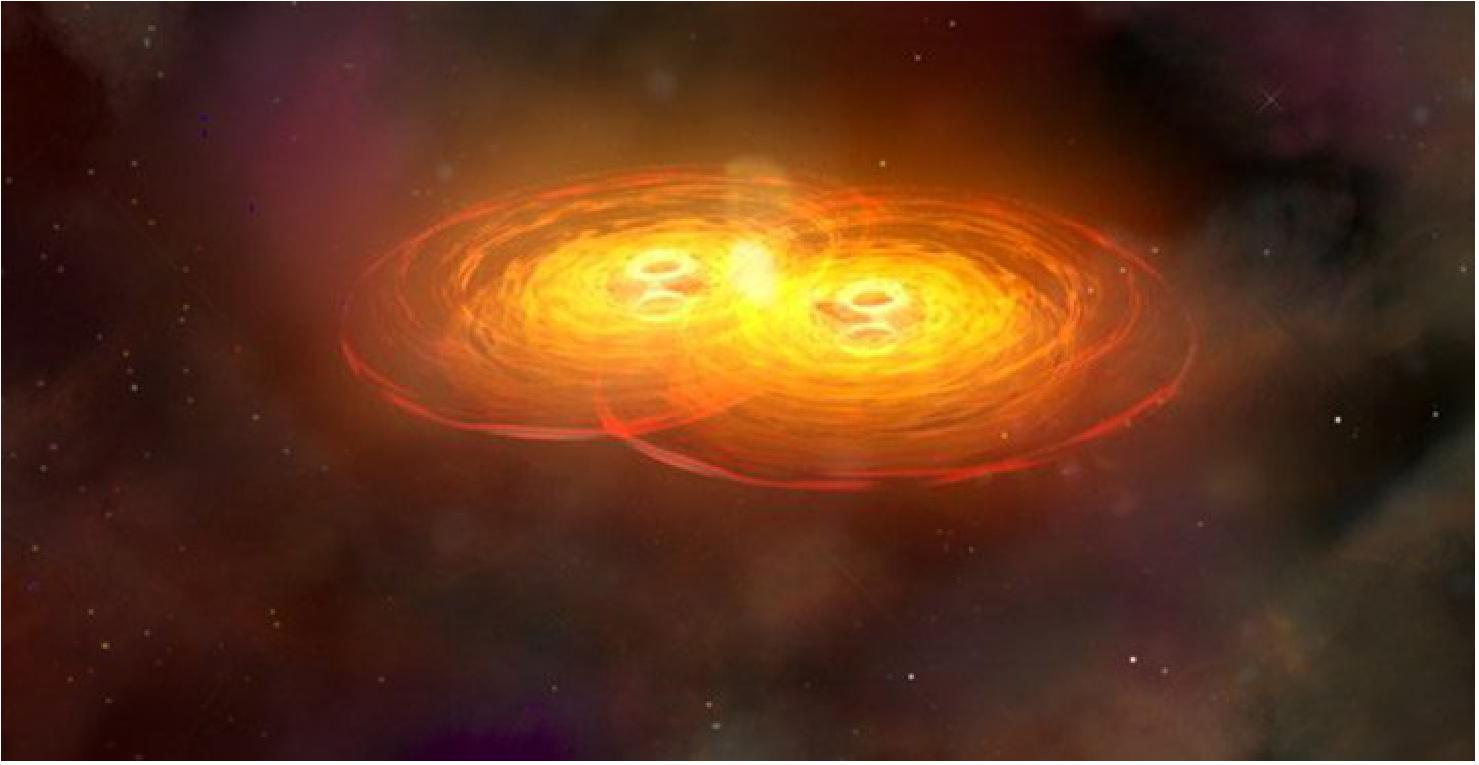
Why BlackGEM?
There are already many telescopes in the world, so why build a new one to see the golden glow? Because no telescope dedicated to the search of these events has the combination of field-of-view and sensitivity required. The golden glows are expected to be faint, and fleeting. Even more importantly: the accuracy with which Advanced LIGO and Virgo can pinpoint these events on the sky is very low: somewhere in an area as large as 400 times the Full Moon. Any telescope that wants to detect the golden glows must therefore:
• be sensitive enough to detect the faint flows ('sensitive')
• have a field-of-view big enough to cover the full area ('wide field')
• be ready to go as soon as an event is detected ('robotic and dedicated')
It was these three requirements that were used to design BlackGEM.
BlackGEM Instrumentation
The BlackGEM array will, eventually, comprise 15 telescopes, each of 65cm diameter. The optical design gives a field-of-view of 2.7 square degrees per telescope. In this way the full array will be able to cover 40 square degrees, and be seeing limited: each telescope will be equipped with a 10500 x 10500 pixel CCD of 9 µm pixel size. With the focal length of the telescope (f/5.5) this will lead to a sky sampling of 0.56”/pixel, well matched to the seeing on La Silla (~1”). 4)
The array mode of BlackGEM is uniquely suited to match the pointing of the telescope to the shape of the gravitational wave error boxes. These are often split and elongated in shape, which makes a monolithic telescope design less suited than the BlackGEM array approach. In case of a detected counterpart, all telescopes can be pointed at the specific position (target mode), in which case the array functions as a single 3.6 m telescope with a 2.7 square degree field of view. Given the fact that counterparts are expected to be fainter than the sky background (~21st magnitude/square-arcsecond) the additional read-out-noise of 15 detectors is not the limiting factor.
When completed the full array of BlackGEM cameras will be the equivalent of a 1.65 Gigapixel detector, by far the largest such a camera in Europe.
The optical and mechanical design of the telescope are completely custom-made to be able to provide seeing-limited image quality. The telescope structure is made from carbon fibre. The design and manufacturing of this carbon fibre structure was achieved through a partnership with Airborne 4) (The Hague, NL) and was funded through an NWO-M (Dutch Research Council) project.

BlackGEM Mission Status
• May 16, 2023: ”BlackGEM telescopes begin hunt for gravitational-wave sources at ESO's La Silla Observatory,” eso2308 — Organisation Release, URL: https://www.eso.org/public/news/eso2308/
Some cataclysmic events in the Universe, such as the collision of black holes or neutron stars, create gravitational waves, ripples in the structure of time and space. Observatories like the Laser Interferometer Gravitational-Wave Observatory (LIGO) and the Virgo Interferometer are designed to detect these ripples. But they cannot pinpoint their origin very accurately nor see the fleeting light that results from the collisions between neutron stars and black holes. BlackGEM is dedicated to quickly scanning large areas of the sky to precisely hunt down gravitational-wave sources using visible light.
“With BlackGEM we aim to scale up the study of cosmic events with both gravitational waves and visible light,” says Paul Groot of Radboud University in the Netherlands, the project’s Principal Investigator. “The combination of the two tells us much more about these events than just one or the other.”
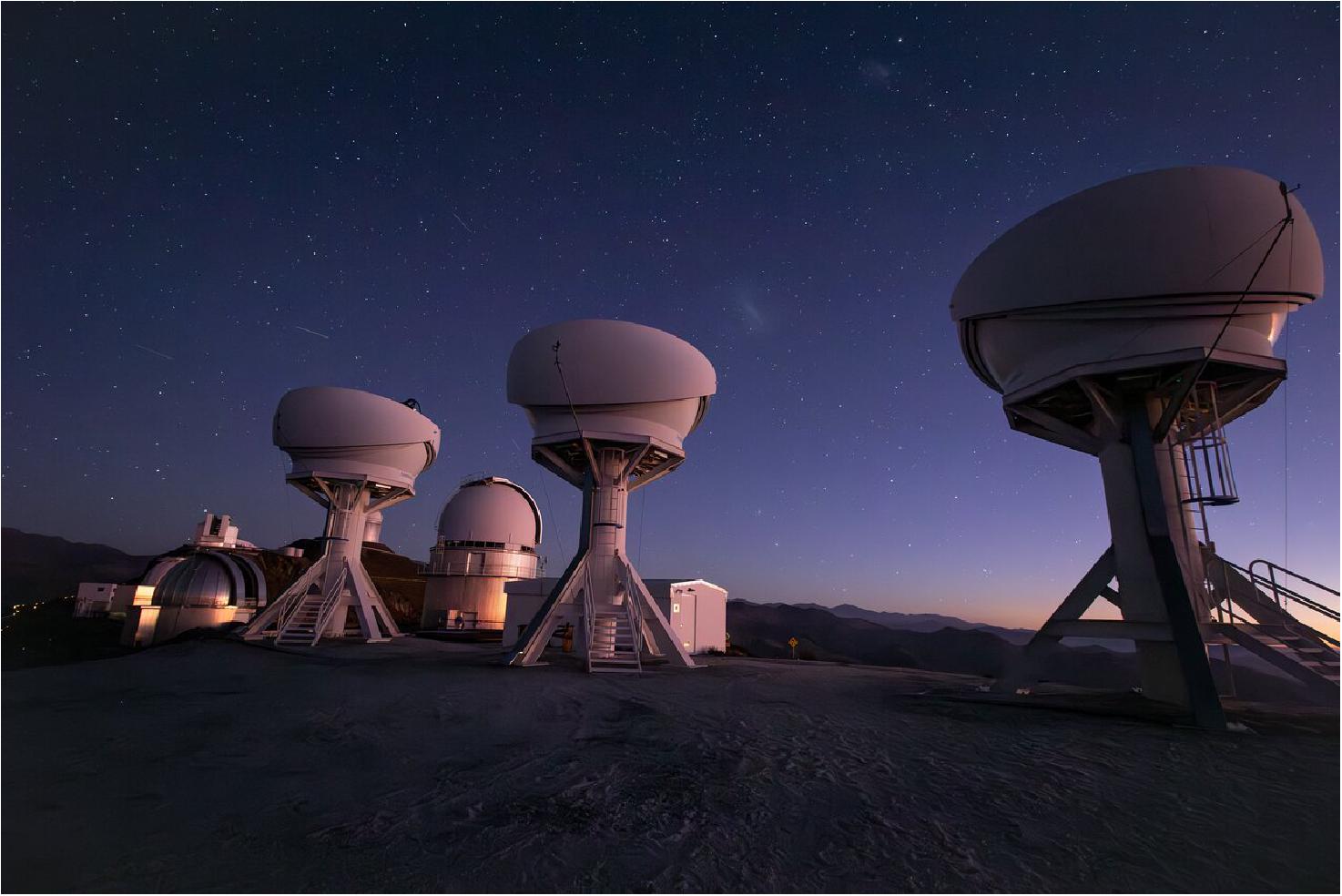
By detecting both gravitational waves and their visible counterparts, astronomers can confirm the nature of gravitational-wave sources and determine their precise locations. Using visible light also allows for detailed observations of the processes that occur in these mergers, such as the formation of heavy elements like gold and platinum.
To date, however, only one visible counterpart to a gravitational-wave source has ever been detected. Furthermore, even the most advanced gravitational-wave detectors such as LIGO or Virgo cannot precisely identify their sources; at best, they can narrow the location of a source down to an area of approximately 400 full moons in the sky. BlackGEM will efficiently scan such large regions at high enough resolution to consistently locate gravitational-wave sources using visible light.
BlackGEM’s three constituent telescopes were built by a consortium of universities: Radboud University, the Netherlands Research School for Astronomy, and KU Leuven in Belgium. The telescopes are each 65 centimetres in diameter and can investigate different areas of the sky simultaneously; the collaboration eventually aims to expand the array to 15 telescopes, improving its scanning coverage even more. BlackGEM is hosted at ESO’s La Silla Observatory in Chile, making it the first array of its kind in the southern hemisphere.
“Despite the modest 65-cm primary mirror, we go as deep as some projects with much bigger mirrors, because we take full advantage of the excellent observing conditions at La Silla,” says Groot.
Once BlackGEM precisely identifies a source of gravitational waves, larger telescopes such as ESO’s Very Large Telescope or the future ESO Extremely Large Telescope can carry out detailed follow-up observations, which will help to shed light on some of the most extreme events in the cosmos.
In addition to its search for the optical counterparts to gravitational waves, BlackGEM will also perform surveys of the southern sky. Its operations are fully automated, meaning the array can quickly find and observe ‘transient’ astronomical events, which appear suddenly and quickly fade out of view. This will give astronomers deeper insight into short-lived astronomical phenomena such as supernovae, the huge explosions that mark the end of a massive star’s life.
“Thanks to BlackGEM, La Silla now has the potential to become a major contributor to transient research,” says Ivo Saviane, site manager at ESO’s La Silla Observatory. “We expect to see many outstanding results contributed by this project, which will expand the reach of the site for both the scientific community and the public at large.”
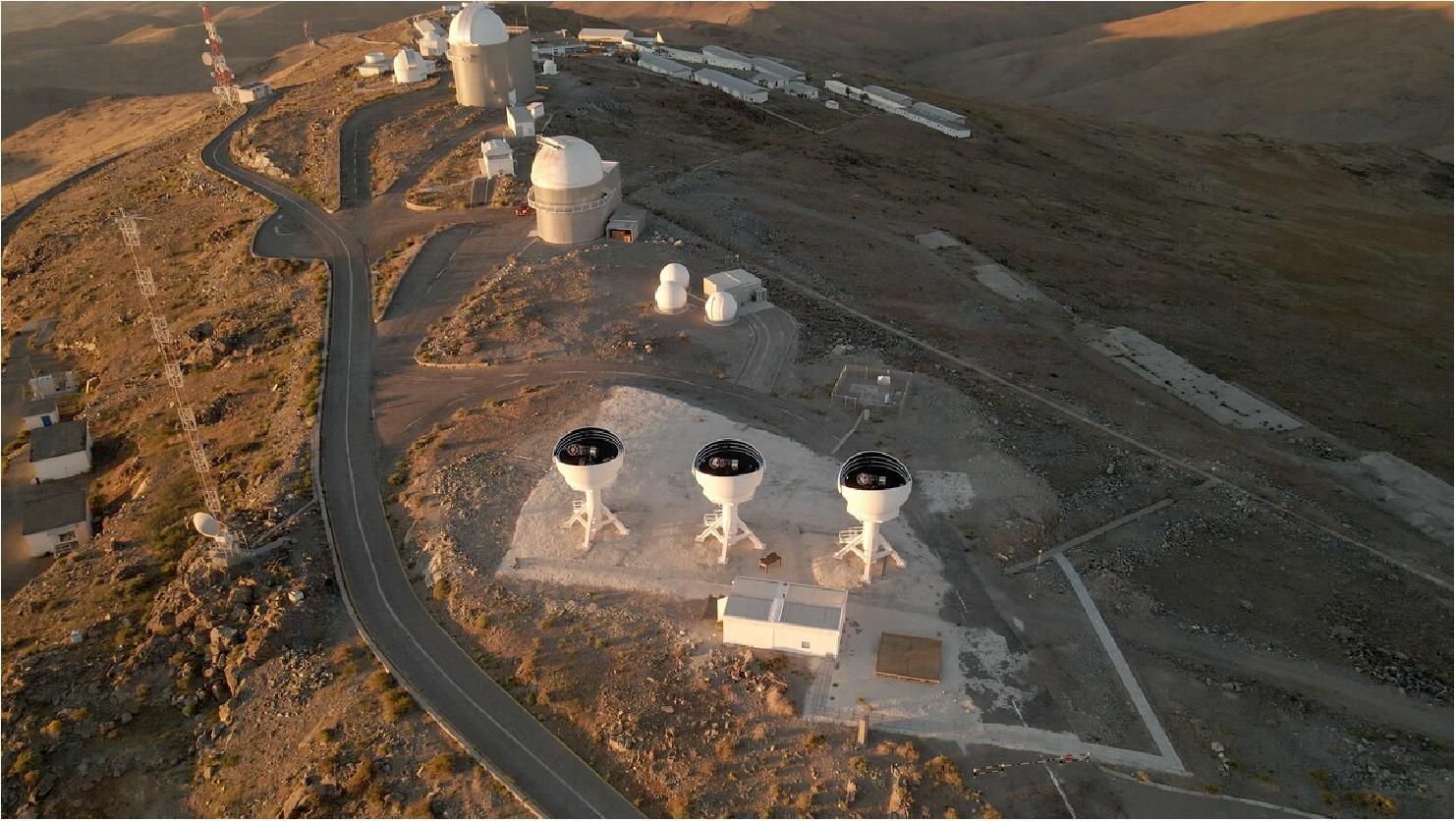
• December 6, 2019: The BlackGEM project brings a wide-field robotic optical telescope array with outstanding image quality, sensitivity and field-of view to the Southern Hemisphere to explore the multi-colour explosive Universe, explains Principal Investigator Paul Groot. 5)
Exploration of the dynamic and explosive Universe is pushing into the minutes-to-hours regime. The detection of counterparts to gravitational wave events1 is foremost in these phenomena, but shock breakouts from supernovae, explosive events associated with white dwarf binaries, fast radio bursts and fast X-ray transients show just how diverse this regime of time-domain astronomy is. The sub-day timescale is waiting to be explored, preferentially using a multi-messenger and/or multi-band approach.
Early models of the expected electromagnetic signals from gravitational wave mergers (see, for example, ref. 2 ) formed the basis for the development of the BlackGEM array in 2012. Coupled with the expected sensitivity of the Advanced LIGO and Virgo detectors, these models show that detecting the optical signals from mergers requires a telescope able to scan a ~100 deg 2 error box, down to the 23rd magnitude on a timescale of ~2 hours, preferably in multiple optical bands to distinguish the mergers from other explosions. These requirements were not met by an existing Southern Hemisphere facility, hence the need for BlackGEM. The Phase 1 array consists of three telescopes, each with a 65 cm main aperture. Using a Harmer–Wynne optical design, a flat and achromatic focal plane of 100 mm x 100 mm is created with an exceptionally stable point-spread function: from the optical axis to the corner of the field the image quality degrades by less than 0.3''. With a telescope focal ratio of f/5.5 and a 110 Mpx CCD, a field of 1.65° x 1.65° (2.7 deg 2) is sampled at 0.56'' per pixel. A six-filter wheel holds an optimized SDSS (Sloan Digital Sky Survey) filter set (u,g,r,i,z) as well as a broadband filter: q, 440–720 nm. Filter changes take <3 s. Operations are robotic, and reaction times to gravitational wave alerts are on the order of one minute.
The high-quality optical design requires an equally high-quality carbon-fibre telescope assembly, heat accounting, site and housing. All heat sources are glycol-cooled, in particular the counterweight that doubles as the electronics cabinet. The telescopes are in clam-shell enclosures, on top of 5 m towers that are double cylinders: the inner cylinder holds the telescope, the outer one the dome with louvers in the floor that open during the night (Figure 9). Solar ground heating is reduced by a cover of white quartz, reducing the night-time turbulent ground air layer, resulting in sub-arcsecond image quality over the full field. The site at La Silla can house the 15 telescopes that are the objective of Phase 2. A further expansion to southern Africa and Australasia would complete a Southern Hemisphere 24/7, wide-field coverage.
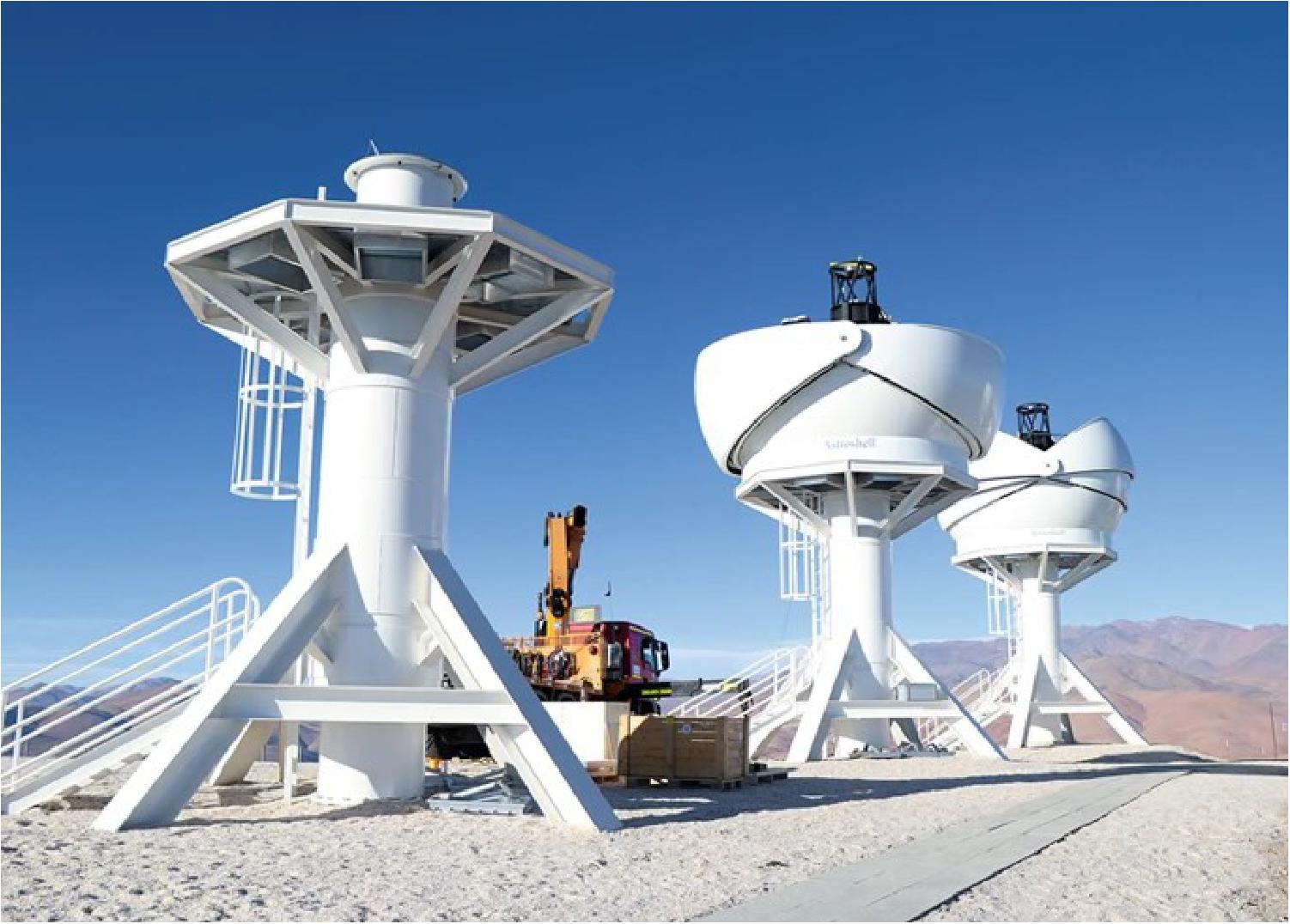
The BlackGEM prototype-telescope MeerLICHT was installed in South Africa in mid-2017. It is now in nightly operation and will soon start shadowing the MeerKAT radio array to create an ‘always-on’ radio–optical synoptic survey. MeerLICHT has a detection zero-point (1 e– s–1) of q = 24.0 mag, demonstrating the very high throughput of the optical system. The installation of the first three BlackGEM telescopes started in August 2019, with an expected first light in early 2020. All data from the BlackGEM array will be processed and hosted in the cloud, in collaboration with Google.
The science program of BlackGEM is dominated by the identification of gravitational wave counterparts. To enable this, the BlackGEM array will create a deep, 22nd magnitude, six-filter survey of the full Southern sky with 1'' image quality. This BlackGEM Southern All Sky Survey will be co-hosted with the European Southern Observatory. To understand and explore the behavior of celestial sources at minute-to-hour timescales, the BlackGEM array will undertake two more surveys: the BlackGEM Local Transient programme, which will target a selection of nearby (<100 Mpc) mass concentrations on a 3-hr timescale in three bands (u,q,i), including a wider q-band bi-nightly survey; and the BlackGEM Fast Synoptic Survey, which will take single deep-drilling fields (2.7 deg 2 ) and stay on a given field continuously for 2–4 weeks in three bands (u,q,i) with a cadence of minutes.
References
1) ”BlackGEM - Joining the search for the sources of gravitational waves,” July 1, 2017, URL: https://www.eso.org/public/teles-instr/lasilla/blackgem/
2) Information provided by Steven Bloemen of Radboud Radio Lab, Radbound University
3) Gert Raskin, Johan Morren, Wim Pessemier, Steven Bloemen, Marc Klein-Wolt, Ronald Roelfsema, Paul Groot, and Conny Aerts, ”PLC-controlled cryostats for the BlackGEM and MeerLICHT detectors,” Proceedings of SPIE, Volume 9908, 'Ground-based and Airborne Instrumentation for Astronomy VI; 99084L (2016),' Event: SPIE Astronomical Telescopes + Instrumentation, 2016, Edinburgh, United Kingdom, URL: https://www.spiedigitallibrary.org/conference-proceedings-of-spie/9908/1/PLC-controlled-cryostats-for-the-BlackGEM-and-MeerLICHT-detectors/10.1117/12.2232485.short?SSO=1
4) ”Technology - A telescope array to detect the golden glow of gravitational wave events ,” URL: https://astro.ru.nl/blackgem/?page_id=23
5) ”The multi-colour dynamic Universe explored,” Paul J. Groot, Nature Astronomy, Vol. 3, December 2019, 1160, URL: https://doi.org/10.1038/s41550-019-0964-z
The information compiled and edited in this article was provided by Herbert J. Kramer from his documentation of: ”Observation of the Earth and Its Environment: Survey of Missions and Sensors” (Springer Verlag) as well as many other sources after the publication of the 4th edition in 2002. - Comments and corrections to this article are always welcome for further updates (eoportal@symbios.space).